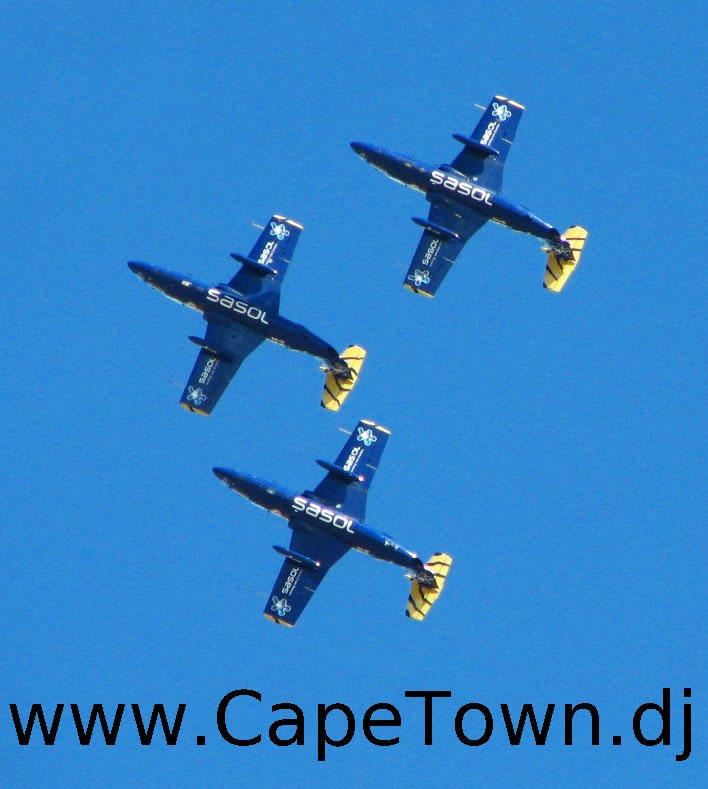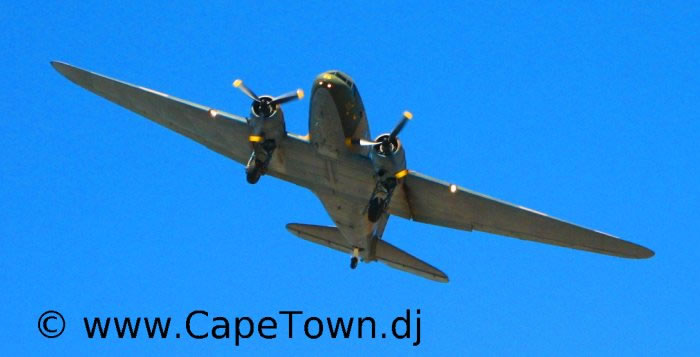Ysterplaat Air Force Base, Cape Town
Situated in Ysterplaat, the Ysterplaat Air Force Base's (Ysterplaat AFB) motto is Fortiter In Re (Resolute in Deed).
Africa Aerospace & Defence – AAD 2006
Military Helicopters |
Jet Aircraft |
|
Propellor-driven aircraft |
Leon van Heerden photos |
|
Sasol Tigers last flight |
||
Photo taken at 1415 during the last flight of the Sasol
(Martin van Straaten died in a plane crash at 1545)

Do you share Manto's worry that George Bush might invade? Want to watch the "most unscrupulous companies in the world exhibit their weapons of death in a carnival-like atmosphere? Anything and everything the mighty and menacing might need to invade a small country was on show at Africa’s largest aerospace, defence, and security exhibition - Africa Aerospace & Defence – AAD 2006 – which was held at the Ysterplaat Airforce Base from the 20th to the 24th September 2006. The Gripen fighter jet stole the show (South Africa recently spent $2.2bn - about R16bn - on a set of Gripen and Hawk fighter planes)...unfortuanately the plethora of desperately starving poor watching below in Khayelitsha cant eat the planes.
Pilot dies after ditching jet
Martin van Straaten, crashed his jet plane into Table Bay near Milnerton. Van Straaten, a 42-year-old mechanical engineer from Johannesburg, was flying an Aero Vodochody L-29 Delfin jet trainer (an older type of Czechoslovakian aerobatics plane). The aircraft was built in 1972 and had logged about 3500 flight hours, it received its last overhaul and service in April 2006; it was a 2-seater aircraft but there was no co-pilot present at the time of the accident. The L-29 Delfin has a maximum speed of 655kmh, was the first jet aircraft ever designed and built in Czechoslovakia. "Delfin" is Czech for dolphin. The 3500kg craft was designed in the late 1950s as a replacement for piston-engined trainers used by the Czechoslovak Air Force, and went into production in 1963.
Van Straaten was an experienced stunt pilot (more than 2500 flight hours) and part of the Sasol Tiger formation aerobatic team (the only jet aerobatic team in South Africa).
Van Straaten had taken off from Air Force Base Ysterplaat as part of a team formation flight. According to eye witnesses, 2 groups of four planes each were practising formation flying at the time (the Sasols and the Silver Falcons), sweeping northwards along the beachfront - "Suddenly one just dropped out of the formation. It dropped very steeply, straight towards the sea. I did not see the pilot eject" - and hit the water at around 15:50. "The aircraft broke into a thousand pieces and water splashed to about 50m above sea level." Witnesses said the pilot made use of his ejector seat but it was too late, as the parachute did not open properly before he hit the water. Teammates were baffled as to why the plane crashed: "I'm just not sure what happened. We were moving in to land, it was our final approach. There were no radio calls, no warning, and then suddenly he just dropped out of formation, and down" Ralf Dominick who led the L-29 Delfin aircraft in formation.
Within minutes, a South African Air Force Oryx helicopter with a rescue team on board was scrambled at Ysterplaat and flown to the scene to attempt to save the pilot. Eyewitness said the helicopter attempted to lift the pilot's body out of the water but because he was still strapped to his parachute it could not pull him out of the water. Van Straaten was declared dead on-scene by paramedics who recovered his body around 1600.
Van Straaten had proposed to his girlfriend just a week before he died. He obtained his wings as a private pilot in 1980 and in 1989 was SA's Sports Aerobatic Champion.
He had a commercial pilot's licence and had been flying L-29s for about six years.
He had around 800 hours of aerobatic flying experience.
He is survived by 3 daughters, aged 15, 12 and nine years, who live in Zimbabwe.

English Electric Lightnings steal the show
With their most spectacular display of formation flying since the end of the cold war, the only 4 remaining English Electric Lightnings in the world stole the show.
The English Electric Lightning was the first and last all-British supersonic fighter. The Lightning is a supersonic interceptor powered by the Rolls Royce Avon 302 after-burning turbo-jet engine known for its vertical climb performance. To this day, the Lightning holds the world climb-to-altitude record capable of Mach 2,2 (2 400 km/h) and an initial climb rate of 15 000m a minute. The Lighnings can be flown at Thunder City.
Noise
"We received about 30 complaints from surrounding areas with regards to the noise over the past five days. But I've explained time and time again that one can't expect a jet aircraft to fly silently, it's just not a possibility. With the huge turnout and the expo being such an enjoyable event, I think people eventually forgave us." Kevin Maxwell, spokesperson for the Metro police
Turnout
More than 60 000 people attended the event on Saturday (2006-09-23), and 40 000 on Sunday (2006-0924).
Provision was made for 15 000 cars to be parked but on Saturday 20 000 cars had packed into the parking lot which was filled again on Sunday.
History
From as early as 1929, the site of Ysterplaat AFB was being used as a civilian airfield, known as Maitland Aerodrome. African Air Transport opened at Maitland in 1938, and was involved in training pilots for the Union Air Training Group's pupil pilot training scheme. AAT moved to Tempe at the start of World War II and Maitland was taken over by the SAAF. On October 24, 1941, Air Force Station Brooklyn, as it was then known, opened as a SAAF unit. 3 and 9 Air Depot's were transferred to Brooklyn for the repair and assembly of aircraft. Air Force Station Brooklyn and 9 Air Depot were disbanded on 31 March 1944. All the activities on the station then fell under 3 Air Depot. Activities on Brooklyn scaled down so much that the airfield was nearly presented to the private sector. In 1946, the first jet aircraft to reach South Africa, a Gloster Meteor III, was assembled and flown at Brooklyn. On the 1st April 1949 Air Force Station Brooklyn was renamed Air Force Station Ysterplaat.
De Havilland Vampire FB Mk.5's jets were assembled at Ysterplaat AFS from 1950 , which (they were the SAAF's first operational jet fighters). On 1 February 1968 AFS Ysterplaat was upgraded to an Air Force Base (AFB). Although Ysterplaat AFB has long been the centre of the SAAF's maritime patrol activities along the Cape coast, due to increased budgetary restrictions the base was scheduled to be downgraded to an Air Force Station on 1 April 2003, but as of September 2006 this had not yet happened. SAAF is considering converting the base into a civilian airport with a military presence, but no decisions have been taken as yet.
Links
References
30 September 2006 |
Private aircrafts‘ performance steals limelight at spectacular exhibition |
25 September 2006 |
|
25 September 2006 |
|
23 September 2006 |
|
22 September 2006 |
|
22 September 2006 |
|
14 September 2006 |
We welcome input to improve our coverage of Ysterplaat Air Force Base, Cape Town